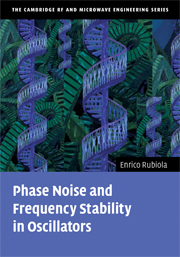Refine search
Actions for selected content:
119150 results for Phase Noise and Frequency Stability in Oscillators
Title match

Phase Noise and Frequency Stability in Oscillators
-
- Published online:
- 24 January 2011
- Print publication:
- 13 November 2008
1 - Phase noise and frequency stability
-
- Book:
- Phase Noise and Frequency Stability in Oscillators
- Published online:
- 24 January 2011
- Print publication:
- 13 November 2008, pp 1-34
-
- Chapter
- Export citation
17 - OSCILLATOR PHASE NOISE
-
- Book:
- Planar Microwave Engineering
- Published online:
- 30 January 2019
- Print publication:
- 30 August 2004, pp 574-600
-
- Chapter
- Export citation
Appendix 10 - Analytical study of oscillator phase noise
-
- Book:
- High-Frequency Integrated Circuits
- Published online:
- 05 March 2013
- Print publication:
- 28 February 2013, pp 876-889
-
- Chapter
- Export citation
8 - Frequency Noise and Frequency Stabilization of QCLs
- from Part II - Active Research Topics
-
- Book:
- Mid-Infrared and Terahertz Quantum Cascade Lasers
- Published online:
- 25 August 2023
- Print publication:
- 14 September 2023, pp 249-274
-
- Chapter
- Export citation
GNSS IF Signal Simulation Considering Oscillator Phase Noise
-
- Journal:
- The Journal of Navigation / Volume 71 / Issue 4 / July 2018
- Published online by Cambridge University Press:
- 05 February 2018, pp. 805-820
- Print publication:
- July 2018
-
- Article
- Export citation
7 - Kurokawa theory of oscillator design and phase-noise theory
-
- Book:
- Nonlinear RF Circuits and Nonlinear Vector Network Analyzers
- Published online:
- 05 July 2011
- Print publication:
- 02 June 2011, pp 201-236
-
- Chapter
- Export citation
GNSS IF Signal Simulation Considering Oscillator Phase Noise – ERRATUM
-
- Journal:
- The Journal of Navigation / Volume 71 / Issue 4 / July 2018
- Published online by Cambridge University Press:
- 09 March 2018, p. 821
- Print publication:
- July 2018
-
- Article
-
- You have access
- HTML
- Export citation
Single transistor low phase noise active dielectric resonator oscillator
-
- Journal:
- International Journal of Microwave and Wireless Technologies / Volume 11 / Issue 10 / December 2019
- Published online by Cambridge University Press:
- 08 August 2019, pp. 1000-1009
-
- Article
- Export citation
5 - Noise in oscillators
-
- Book:
- Integrated Frequency Synthesizers for Wireless Systems
- Published online:
- 09 August 2009
- Print publication:
- 28 June 2007, pp 103-132
-
- Chapter
- Export citation
Sideband stabilization in the presence of LO phase noise: analysis and system demonstrator
-
- Journal:
- International Journal of Microwave and Wireless Technologies / Volume 6 / Issue 2 / April 2014
- Published online by Cambridge University Press:
- 06 December 2013, pp. 129-137
-
- Article
- Export citation
The linear stability of high-frequency flow in a torsionally oscillating cylinder
-
- Journal:
- Journal of Fluid Mechanics / Volume 576 / 10 April 2007
- Published online by Cambridge University Press:
- 28 March 2007, pp. 491-505
-
- Article
- Export citation
A low phase noise and frequency agility synthesizer for millimeter-wave transceiver
-
- Journal:
- International Journal of Microwave and Wireless Technologies / Volume 9 / Issue 8 / October 2017
- Published online by Cambridge University Press:
- 11 April 2017, pp. 1611-1618
-
- Article
- Export citation
A modified Jerusalem microstrip filter and its complementary for low phase noise X-band oscillator
-
- Journal:
- International Journal of Microwave and Wireless Technologies / Volume 15 / Issue 10 / December 2023
- Published online by Cambridge University Press:
- 23 June 2023, pp. 1707-1716
-
- Article
- Export citation
24 - Amplifier and oscillator noise analysis
-
- Book:
- Radio-Frequency Electronics
- Published online:
- 05 June 2012
- Print publication:
- 11 June 2009, pp 336-348
-
- Chapter
- Export citation
5 - Noise in delay-line oscillators and lasers
-
- Book:
- Phase Noise and Frequency Stability in Oscillators
- Published online:
- 24 January 2011
- Print publication:
- 13 November 2008, pp 125-149
-
- Chapter
- Export citation
Phase noise performance stabilization of PLL system under dynamic vibration condition for airborne applications
-
- Journal:
- International Journal of Microwave and Wireless Technologies / Volume 13 / Issue 4 / May 2021
- Published online by Cambridge University Press:
- 30 July 2020, pp. 335-343
-
- Article
- Export citation
18 - PHASE NOISE
-
- Book:
- The Design of CMOS Radio-Frequency Integrated Circuits
- Published online:
- 05 June 2012
- Print publication:
- 22 December 2003, pp 659-693
-
- Chapter
- Export citation
15 - Phase noise and phase distortion
-
- Book:
- Theory of Remote Image Formation
- Published online:
- 19 August 2009
- Print publication:
- 18 November 2004, pp 499-512
-
- Chapter
- Export citation
15 - Phase Noise and Phase Distortion
-
- Book:
- Theory of Image Formation
- Published online:
- 17 April 2025
- Print publication:
- 24 April 2025, pp 575-589
-
- Chapter
- Export citation
